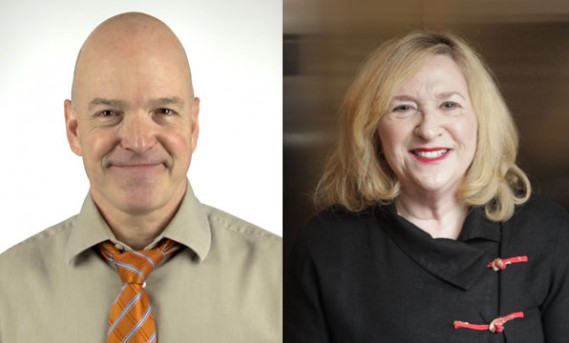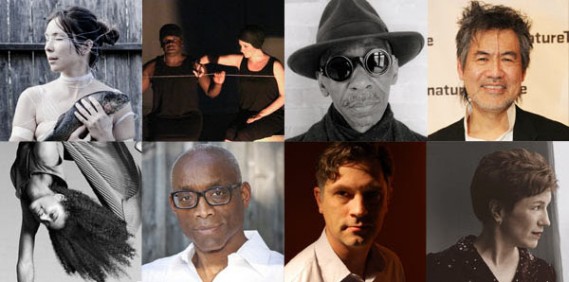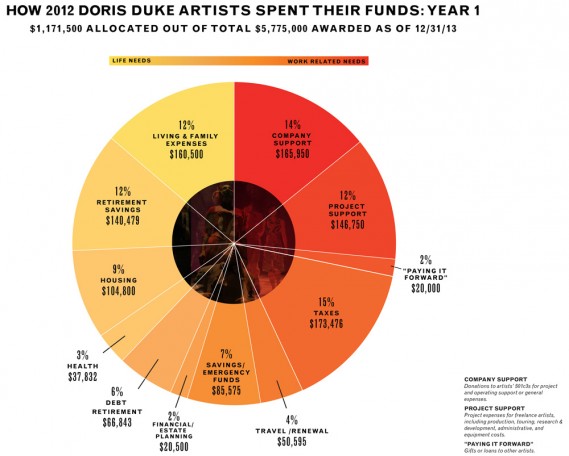The Doris Duke Performing Artist Awards Program: What Have We Learned?

Ben Cameron, Program Director for the Arts at the Doris Duke Charitable Foundation, and Ruby Lerner, Creative Capital’s President & Founding Director
Ruby Lerner: Thanks for taking the time to speak with me, Ben! A bit of background, before we get started: In 2011, the Doris Duke Charitable Foundation asked Creative Capital to partner with them to launch and oversee the Doris Duke Performing Artist Awards Program (DDPAA), which announced its third class of awardees yesterday. I know that we’re both so excited to begin working with this extraordinary roster of artists. We talked about the birth of DDPAA in an interview for this blog back in April 2012, so we thought it would be interesting to do a “Part Two” now about what has been learned over the past few years working together to bring the program to life. We had a similar discussion on a session at last year’s Grantmakers in the Arts conference in Philadelphia.
Thinking back on the initial vision for the DDPAA program, what do you think the biggest changes have been (if any) to adapt the program to the needs of the artists?
Ben Cameron: The changes the program has experienced have been primarily logistic rather than conceptual. We have learned a lot about more effective administration for the program and have instituted a more predictable schedule for reports and cash requests, for example. We have learned more about how to optimize the orientation meeting for each new class of awardees. But the basic ability of the program to respond to artists—the flexibility of unrestricted funding (which the bulk of the grant is)—hasn’t really changed.
I think this year has forced us to be clearer about the two tiers of support that the program offers—to clarify the distinctions between Doris Duke Artists and the Impact Award grantees. The two awards were conceived for different kinds of artists, and the selection process is quite different. Having to pinpoint those differences was a challenge, both for us internally and for the nominators for the Impact Awards. But again, the concept of multi-year, largely unrestricted funding still remains valuable and largely unchanged.

2014 Doris Duke Artists, clockwise from top left: Emily Johnson, Nancy Keystone, Roscoe Mitchell, David Henry Hwang, Lisa Kron, John Collins, Bill T. Jones, Joanna Haigood
Ruby: I would agree. I am particularly interested to see how these two awards work together. Both rosters are extraordinary and I know the artists will benefit from the relationship between the two programs.
What excites me is the artist-to-artist nature of the Impact Awards—the fact that they are nominated by the previous classes of Doris Duke Artists. It is a really lovely way to honor how much artists know about their fields, and how generous they are. And discerning!
Ben: I think the Impact Award recipients are especially moved by that. On the phone calls where we told them the were receiving the award and that the Nominators were past Doris Duke Artists, they were even more thrilled—tears, joy, elation all expressed in ways that would have perhaps not been as strong were this role of artists as nominators not the case. My only regret of course is that, with such a large pool of worthy nominees, we didn’t have funds to offer them all awards!

Recipients of 2014 Doris Duke Impact Awards, clockwise from top left: Michael Sommers, Ambrose Akinmusire, Lucia Neare, Anna Halprin, Aruán Ortiz, Jodi Melnick, Jennifer Monson, Cristal Chanelle Truscott
Ruby: I know! That is always the heartbreaking part. I wanted us to talk a bit about how the Doris Duke Artists are deploying the award funds so far. Are they being used pretty much in the way you imagined, or have there been any surprises?
Ben: Well, of course the only confirmed use of funds we have so far is how the first class spent their first year of funds—which really means how 21 artists spent the first $1.2 million of their combined $5.725 million of award monies. We’ve been working on a chart to illustrate the expense categories, and of course, the realities of an artist’s life do hit hard. The use of funds for housing, for example, debt retirement and health care are substantial. I know some artists have started archives of their work, which is fantastic, and others have broadened their skills through study or travel. I only wish, of course, that the tax burden weren’t so significant on these artists! Might we hope for the days where, like Ireland, there are at least some artists of national merit who are exempted from income taxes?

Ruby: Wouldn’t that be great! I think one lesson we’ve learned is how much help artists—even mature ones—need in the financial planning and management arena. Longer term, we need to really look at this as a field and do a better job of training artists in this area, starting early in their careers. This is something we have been looking at in our professional development work, not just with our own grantees but the workshops we do around the country. We now have a one-day workshop, Financial Literacy for Artists, and we’re offering webinars like Real Life Budgeting. I’m really proud of the offerings, and think there’s more we could develop along those lines.
I want to move to the interface with Creative Capital services. It was so wonderful to have the last group of Doris Duke Artists at our 2013 Artist Retreat, and we hope to grow their presence at future gatherings. We have a brand new office space now too, and it is going to be a great home for conversations and gatherings—and hopefully, a place for our artists to come and just bring their laptops and hang out! We have designated an area we are calling the “Artists’ Funhouse.” We hope to see the DDPAA awardees there too!
Ben: I heard the Retreat was fantastic and was so sorry my schedule was in conflict and I couldn’t go! We’ll do our best to direct the new DDPAA recipients to your new space. It has been the partnership with Creative Capital and the leadership of DDPAA Program Director Rachel Ford and her team that have really made this program work. The impact of the services, the emphasis on self-directed use of funds, the individually determined payout schedules, and the planning—all wouldn’t have been possible without Creative Capital!
Ruby: That is so nice to hear! I loved and was so moved by your initial vision for the program and it has been such a joy and honor to go on this journey with you and the rest of the Doris Duke Foundation. What I also appreciate is your willingness to be improvisational, to change course if things don’t appear to be working. Our adaptive partnership is what will keep this program strong and make it a compelling model for the field. THANK YOU!
Ben: Our pleasure and honor.
You can read more about the Doris Duke Performing Artist Awards and browse the 2014 recipients at ddpaa.org.
